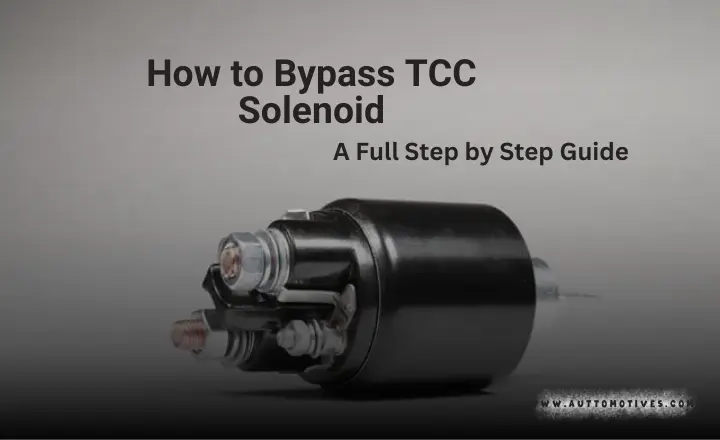How to Bypass TCC Solenoid | A Full Step by Step Guide
If you are looking for a step-by-step guide for How to Bypass TCC Solenoid, then you will find the complete details here. The abbreviation of TCC Solenoid is Torque Converter Clutch. The torque converter is a component in an automatic transmission that allows the engine to spin independently of the transmission when the vehicle is stationary or at low speeds. It keeps fluid pressure constant and prevents overheating. It controls the torque converter lockup. It results in low fuel consumption and heat transmission. Sometimes, the solenoid fails and you have to replace it. But replacement is an expensive method. Here we will be sharing the guide to bypass it.
How to Bypass TCC Solenoid
There are several reasons the TCC solenoid of your vehicle fails. It may be due to some wiring or electric issues. You may experience that it is working badly by experiencing some bad things happening with your vehicle. It will also face transmission issues. The procedure How to Bypass TCC Solenoid is given below and you have to follow these steps to get it fixed.
Connect the Standard Bulb to the PCM Circuit
The Powertrain Control Module in a car carries out various tasks like timing the engine, managing emissions, and shifting the transmission. For the connection, follow the steps given below.
- First, you have to find the diagnostic connector. It is present under the car, so find it there.
- After locating it, you have to find its pins.
- Out of all these pins, you have to find pin number 13.
- Now, to add the bulb to the circuit, attach one end of the wire to the pin and the other end to the bulb holder. Attach the other wire from the bulb holder to the ground.
Connect the Bulb to the Ignition
After connecting the PCM and Bulb, the next step is to connect the bulb to the ignition. For this, you have to follow the steps mentioned below.
- Find the ignition connector and disconnect it.
- Locate the wire of the ignition that is connected to the switch.
- After finding it, connect it with a jumper wire. Attach the alligator clip to its other end.
- You have to connect the terminals to the standard bulb socket’s ends. This will result in the connection of the bulb to the ignition.
After you have done it, now the step is to test the TCC solenoid and diagnose the problem.
How to Test TCC Solenoids?
Before you go for the bypass step, you must know where the problem actually lies. For this, you have to test it first. It will help you to detect the problem and solve the issue. So, the steps of testing the solenoid are mentioned below.
Lift the Car
In this step, we will be finding any discontinuity in the wiring.
- To lift your car, use a jack.
- Check for the transmission where you will find the wiring harness for TCC Solenoid.
- You have to unplug this and to check the continuity here, use a multimeter.
Remove the Transmission Bolts
- In this step, drain the fluid from the transmission and remove the bolts.
- Now you have to lower the transmission away from its mounting points.
- At the bottom of the transmission, you will also find the pan.
- To remove the pan, you need to be very careful because there are some important components present here.
- Remove the bolts and use a flathead screwdriver to pry off the pan.
- So, here you will find the TCC solenoid.
Unplug the Solenoid
Now you have to find the solenoid, next you just have to unplug and test it. Check the resistance using an ohmmeter. These readings will help you acknowledge whether it is good or not. Read the complete procedure of How to Unplug the TCC Solenoid.
What the TCC Solenoid Does
When the car is stopped or moving slowly, the torque converter, a part of an automatic transmission, enables the engine to spin separately from the transmission. This allows the engine to keep running even when the vehicle is stopped or idling. However, the power from the engine is more effectively transferred to the transmission without a torque converter in order to avoid slippage as the car accelerates. When the car reaches a certain speed, usually greater than 30 to 40 miles per hour, the TCC solenoid is in charge of engaging the torque converter clutch.
Why TCC Solenoid May Fail
There are several reasons the Torque Control Converter may fail. It may be because of high mileage or wear and tear. In addition, there may be some issues with the wiring. It results in some issues with the TCM. The consequences will be poor regulation of solenoids. Some other reasons may include a dirty transmission filter. So, you must take care of the regular maintenance.
Symptoms of a Bad Solenoid
You may experience different issues with your vehicle if the solenoid is bad. The symptoms are given below.
- In case of a bad solenoid, the check engine light may illuminate.
- When the TCC solenoid malfunctions, the vehicle may stall when stopped because the torque converter remains locked.
- You may experience slippage in transmission.
- The most common symptom is that the gear shift is not working properly.
FAQs
Can you drive without a TCC solenoid?
Yes, you can drive without TCC Solenoid. If you have a manual transmission, you can drive without it. But it is not advisable because you will face a lot of issues.
What happens when a torque converter solenoid goes bad?
In this case, the TCC will not achieve lockup. So, your vehicle will consume more fuel. In addition, there will be more internal heat and this will result in damage to the components.
The procedure is mentioned here which can be used to check whether the TCC Solenoid is working well or not. So, hopefully, you got all the details you were looking for. That’s all about How to Bypass TCC Solenoid. It is all you can get from this post. Get other details here for more relevant posts.







